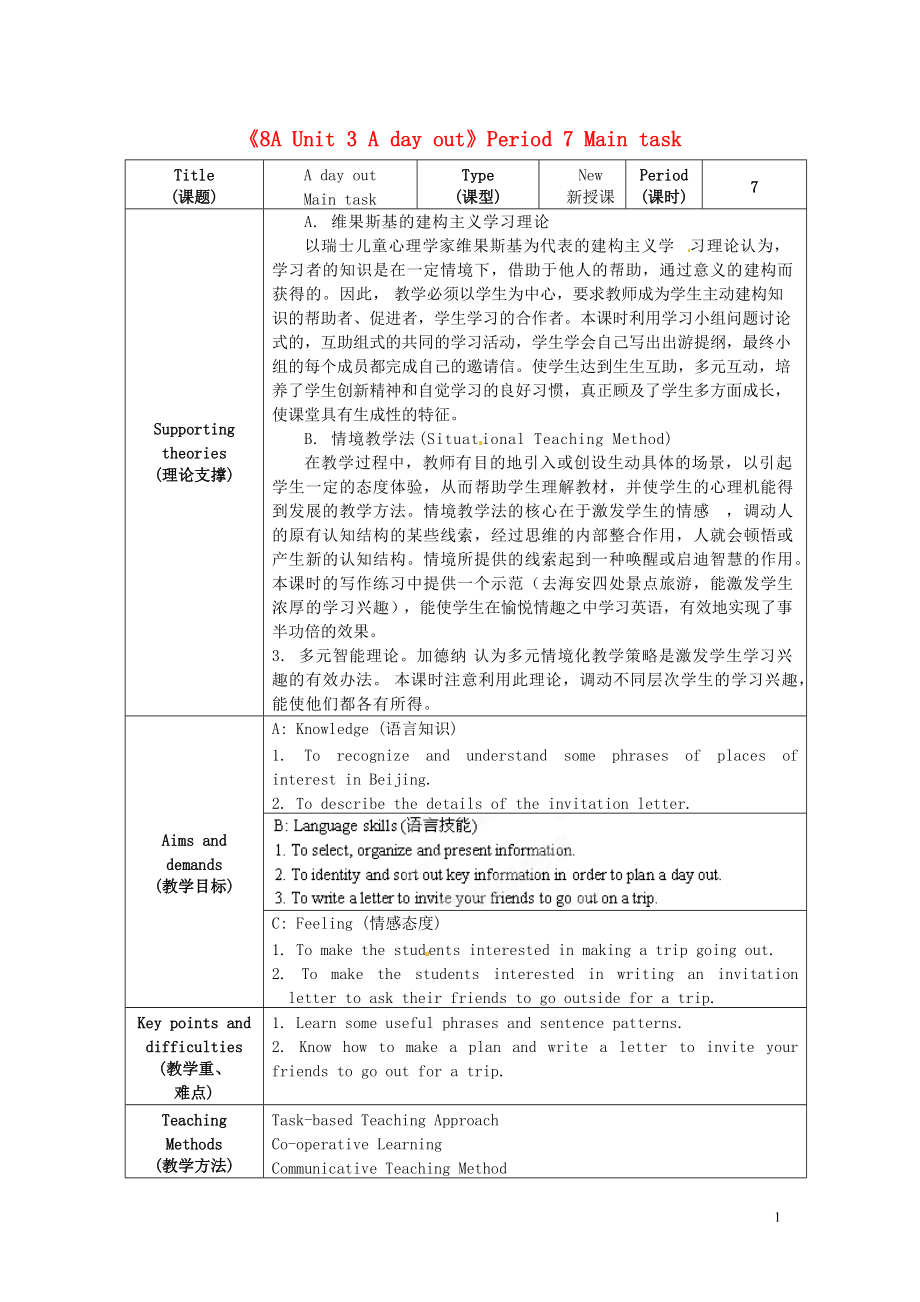《江蘇省海安縣大公初級中學(xué)八年級英語上冊《8A Unit 3 A day out》Period 7 Main task教案 牛津版》由會員分享���,可在線閱讀���,更多相關(guān)《江蘇省海安縣大公初級中學(xué)八年級英語上冊《8A Unit 3 A day out》Period 7 Main task教案 牛津版(6頁珍藏版)》請在裝配圖網(wǎng)上搜索�。
1、
《8A Unit 3 A day out》Period 7 Main task
Title
(課題)
A day out
Main task
Type
(課型)
New
新授課
Period
(課時)
7
Supporting theories
(理論支撐)
A. 維果斯基的建構(gòu)主義學(xué)習(xí)理論
以瑞士兒童心理學(xué)家維果斯基為代表的建構(gòu)主義學(xué)習(xí)理論認(rèn)為���,學(xué)習(xí)者的知識是在一定情境下��,借助于他人的幫助��,通過意義的建構(gòu)而獲得的���。因此,教學(xué)必須以學(xué)生為中心���,要求教師成為學(xué)生主動建構(gòu)知識的幫助者���、促進(jìn)者���,學(xué)生學(xué)習(xí)的合作者。本課時利用學(xué)習(xí)小組問題討論式的�����,互助組式的共同的學(xué)
2��、習(xí)活動����,學(xué)生學(xué)會自己寫出出游提綱,最終小組的每個成員都完成自己的邀請信��。使學(xué)生達(dá)到生生互助�����,多元互動��,培養(yǎng)了學(xué)生創(chuàng)新精神和自覺學(xué)習(xí)的良好習(xí)慣���,真正顧及了學(xué)生多方面成長����,使課堂具有生成性的特征。
B. 情境教學(xué)法(Situational Teaching Method)
在教學(xué)過程中���,教師有目的地引入或創(chuàng)設(shè)生動具體的場景�����,以引起學(xué)生一定的態(tài)度體驗���,從而幫助學(xué)生理解教材,并使學(xué)生的心理機(jī)能得到發(fā)展的教學(xué)方法�。情境教學(xué)法的核心在于激發(fā)學(xué)生的情感,調(diào)動人的原有認(rèn)知結(jié)構(gòu)的某些線索�����,經(jīng)過思維的內(nèi)部整合作用�,人就會頓悟或產(chǎn)生新的認(rèn)知結(jié)構(gòu)�。情境所提供的線索起到一種喚醒或啟迪智慧的作用。本課時的寫作練習(xí)中提
3��、供一個示范(去海安四處景點旅游����,能激發(fā)學(xué)生濃厚的學(xué)習(xí)興趣)�,能使學(xué)生在愉悅情趣之中學(xué)習(xí)英語���,有效地實現(xiàn)了事半功倍的效果�����。
3. 多元智能理論����。加德納認(rèn)為多元情境化教學(xué)策略是激發(fā)學(xué)生學(xué)習(xí)興趣的有效辦法����。本課時注意利用此理論,調(diào)動不同層次學(xué)生的學(xué)習(xí)興趣����,能使他們都各有所得。
Aims and demands
(教學(xué)目標(biāo))
A: Knowledge (語言知識)
1. To recognize and understand some phrases of places of interest in Beijing.
2. To describe the details of the
4���、 invitation letter.
C: Feeling (情感態(tài)度)
1. To make the students interested in making a trip going out.
2. To make the students interested in writing an invitation letter to ask their friends to go outside for a trip.
Key points and difficulties
(教學(xué)重�、
難點)
1. Learn some useful phrases and sen
5��、tence patterns.
2. Know how to make a plan and write a letter to invite your friends to go out for a trip.
Teaching Methods
(教學(xué)方法)
Task-based Teaching Approach
Co-operative Learning
Communicative Teaching Method
Aids:
課前準(zhǔn)備(教具���、活動準(zhǔn)備等)
1. Get some information about a day out trip.
2. Ge
6����、t some pictures of places of interest in Beijing.
教 學(xué) 設(shè) 計
課前延伸
(預(yù)習(xí))
1. 閱讀Kitty and Daniel’s plan for the trip(P53)和An invitation letter(P54),了解大意����。
2. 英漢互譯一些重要短語。
3. 解決疑難問題�����。
(個人思考���,小組討論���,疑難問題待課上求助)
培養(yǎng)學(xué)生養(yǎng)成良好的自學(xué)習(xí)慣���,及較強(qiáng)的自學(xué)能力�,為今后的英語學(xué)習(xí)發(fā)展打下堅實的基礎(chǔ)�����。
Teaching Plan
(授課計劃)
Studying Plan
(學(xué)習(xí)計
7、劃)
Aims
(設(shè)計意圖)
課
內(nèi)
拓
展
學(xué)
StepⅠWarming up
1. Review work
The teacher leads the students go over Integrated skills.
1) When does the final start? (At 10.30 am.)
2) Where do they watch the fin
8����、al? (South Hill School)
3) How do they go there? (By bus)
4) How much is the ticket? (Ten yuan per person)
5) What do you think of their trip?
6) (Students’ own answers)
2. Check the preview exercises.
1. 老師設(shè)問,鞏固舊知�,為導(dǎo)入新課服務(wù)。
2.檢查課前預(yù)習(xí)作業(yè)�����,督促學(xué)生課前認(rèn)真預(yù)習(xí)���。
Step II Pr
9�、esentation
(Pre-reading)
1. Ask the students what places of interest Linda will visit.
2. Present some guiding questions and ask the students to read and understand the notes of plan.
1) How many places of interest are they going to visit? What are they?
2) What will they do in Beihai Par
10���、k?
3) How will they get to the Palace Museum from Sunshine Underground Station?
4) What will they do at Tian’anmen Square?
5) How much time will they spend at Tian’anmen Square?
6) When will they leave Wangfujing Street?
1. 通過詢問Linda會參觀北京的哪些名勝古跡��,為接下來的教學(xué)環(huán)節(jié)做好鋪墊����。
2. 問答有關(guān)出游計劃內(nèi)容����,檢查學(xué)生對計劃的理
11�����、解程度���。
導(dǎo)
Step III
Practice
( While-
reading)
Ⅰ. Skimming
1. Ask students to answer the questions.(Part A)
2. Come to a summary:
Now work in pairs to sum up what information should be included in a trip plan. (Part B)
1. 通過對學(xué)生的聽讀訓(xùn)練,培養(yǎng)其搜索及提取有用信息的能力�。
2. 強(qiáng)化聽說訓(xùn)練,提高學(xué)生對文章細(xì)節(jié)的理解和推斷能力�。
I
12、I.
Scanning
1. Finishing off Part C
Help Kitty and Daniel complete their letter to their classmates using the information in Part A.
2. Check the answers in groups and ask five students to read the letter.
3. Read the letter together.
4. Help the students understand some difficult sentences an
13����、d phrases:
1) We will then take the underground to the center of Beijing and change to the bus.
2) We will take the bus all the way to the Palace Museum.
3) We will make it a really fun day for everyone.
4) If you want to come, please let us know as soon as possible.
5) We hope you can join
14、 us.
5. Sum up the structure of a letter to invite others to go out for a trip .
Part 1: Purpose of the letter.
Part 2: Plan.
Part 3: Cost.
Part 4: Instructions.
附加:Date; Name of the receiver, Closing, Signatures.
尊重學(xué)生的個性差異�,分層要求。在學(xué)生自學(xué)過程中��,教師通過觀察�、詢問,有計劃地點撥學(xué)困生���,鼓勵其大膽質(zhì)疑;有針對性地向優(yōu)生提出深層次的問題,使他
15���、們的聰明才智得到充分發(fā)揮�。
練
Step IV
Production
(Post-reading)
Ⅰ. Discussion
II. Writing.
1. Designing a new plan based on the model on page 53.
2. Write a letter according to your own plan. I will ask a few more able students in each group to present their letters to the class.(Part D)
3.
16����、Make a speech.
(1) Each group chooses one student to come to the front to give us a speech.
(2) Give some presents to the best group.
四人學(xué)習(xí)小組為單位,合作交流�,取長補短,集思廣益�,推優(yōu)向全班展示成果。(教師巡視����、了解,點撥有困難的學(xué)生大膽開口����,引導(dǎo)優(yōu)生發(fā)揮才智。充分體現(xiàn)面向全體學(xué)生�����,注重他們整體素質(zhì)的提高�����。)
課后
提升
Step V Assignment
1. Recite all the phrases and sentences.
2. Check the plan and the letter again and prepare to present them to the whole class in the next period.
3. Finish off the exercises in student’s workbook.
加強(qiáng)寫作訓(xùn)練及課后鞏固練習(xí),注意控制作業(yè)量��,既落實雙基����,又重視知識面的拓寬和能力的提升。(關(guān)心學(xué)生的認(rèn)知發(fā)展)
6
 江蘇省海安縣大公初級中學(xué)八年級英語上冊《8A Unit 3 A day out》Period 7 Main task教案 牛津版
江蘇省海安縣大公初級中學(xué)八年級英語上冊《8A Unit 3 A day out》Period 7 Main task教案 牛津版

